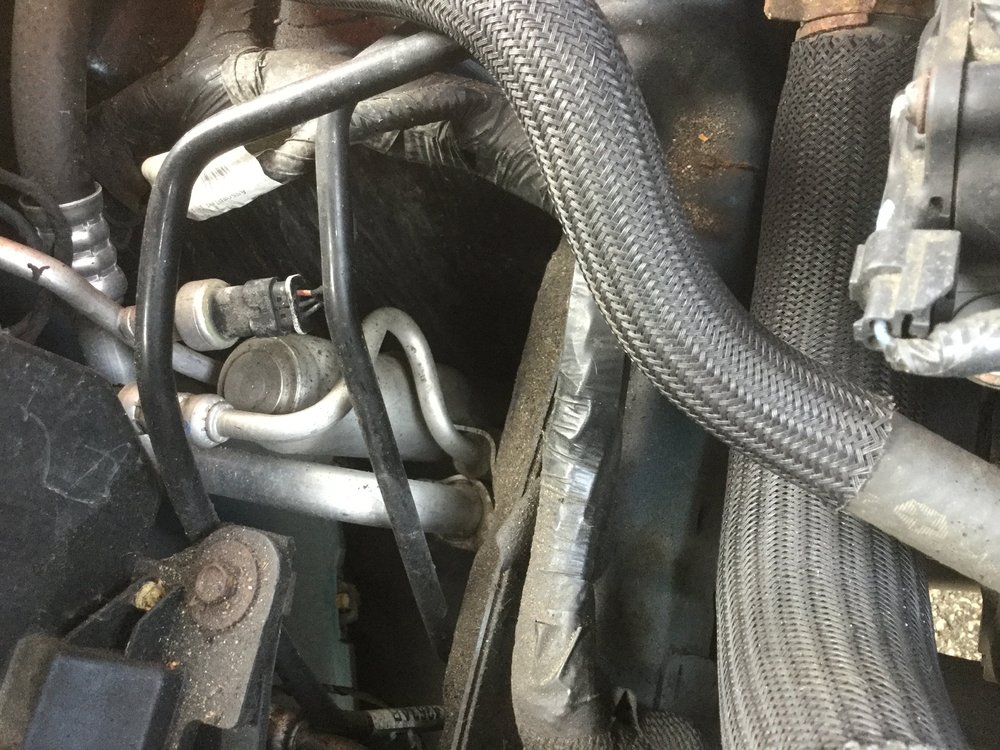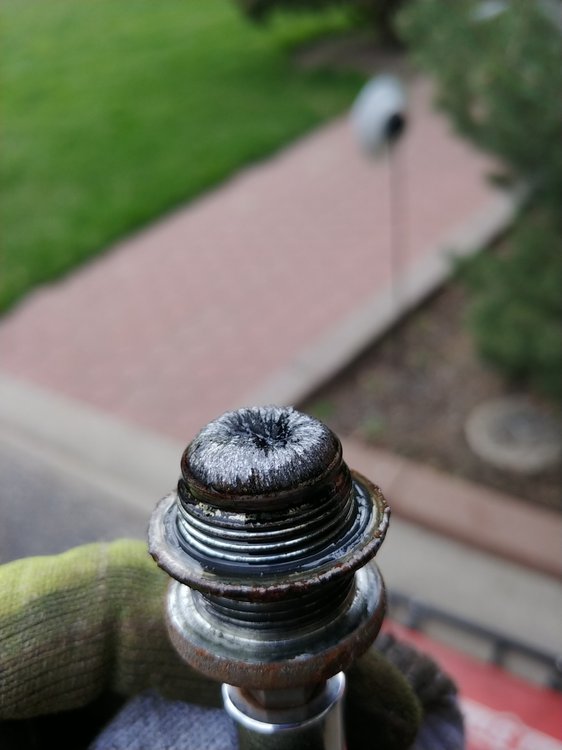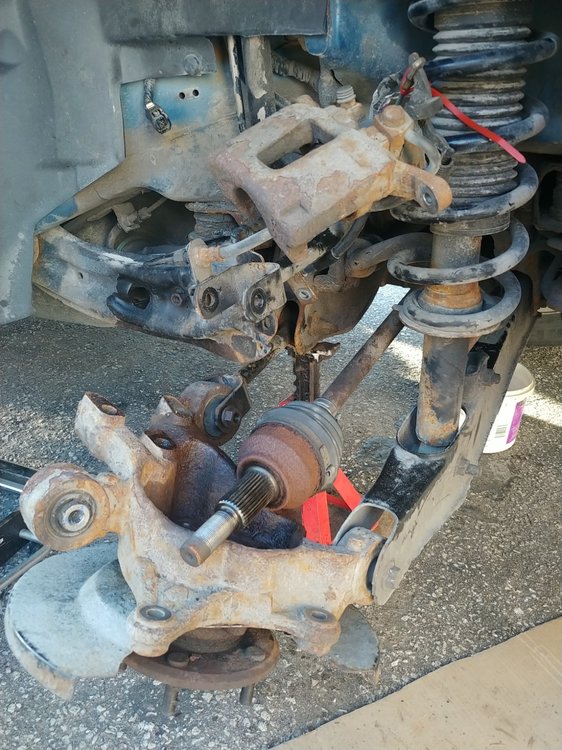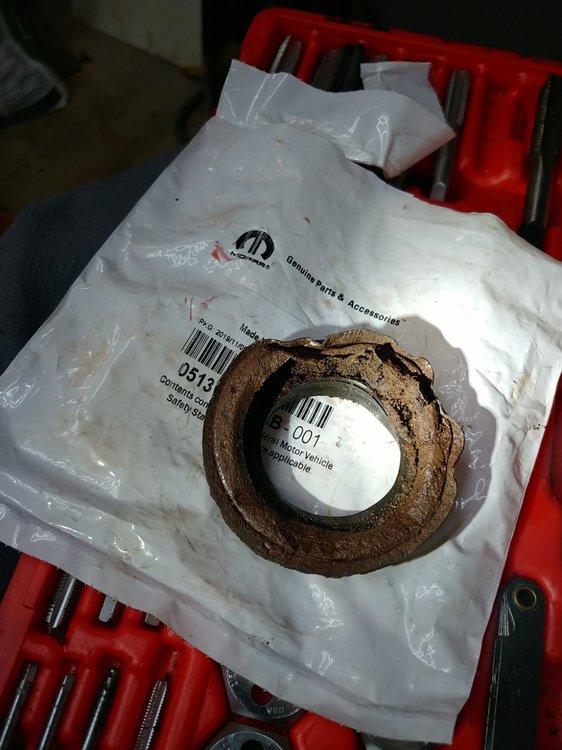-
Posts
1,834 -
Joined
-
Last visited
-
Days Won
188
Content Type
Profiles
Forums
Gallery
Everything posted by John/Horace
-
This looks like low side switch, it’s on the same line as charging port. High pressure side on a/c can reach over 210psi-ish which is shrapnel making velocity potential. Wear your jock and your goggles.?? If some refrigerant charge still partly there and no air (moisture mainly) got into system might be ok. If compressor starts up, start looking on high side, especially condenser coil across rad for hissing large leak.
-
If you can, remove the wheel spacers. They tend to wear out bearings and it’s better not to have them if possible. How many miles on car? Some mechanics have listening device to trouble shoot bearings etc. Rear driveshaft on awd vehicles can often be removed temporarily to prove if that’s the cause, pricy item to replace. I drove my grand Cherokee for its last two years without rear drive shaft, $1000 viscous coupling repair couldn’t be justified. Removing driveshaft was a 15 minute one wrench only job. There is one changeable part on driveshaft. https://www.rockauto.com/en/catalog/dodge,2014,journey,3.6l+v6,3300354,drivetrain,drive+shaft+flex+joint,10701
-
Which engine four or six. Scanning for codes is usually first step. Fuse for push button start in passenger kick panel should be checked F121 I believe. It’s called wireless control module in owners manual.
- 3 replies
-
- check engine
- wont start
- (and 4 more)
-
Yeah should be a signal triggering clutch on compressor from hvac system. I haven’t had to work on my wife’s journey a/c yet, more familiar with older hyundai a/c.
-
Pressure is higher with system off, drops when running. Sounds like you have pressure so not empty system. You have your answer. Could check if 12 volt signal is coming to compressor plug when a/c is turned on. If not could be hvac control issue.
-
R134 is no that powerful for cooling and leak prone in my experience. How did you get kit for the different refrigerant ? Make sure it’s says compatible or you will have a mess. If it’s low it will feed into system from can and release low pressure switch and allow compressor to run. If you leave pierce valve all the way in and don’t back it off after piercing can no gas can be released into system. It takes up to approx. 5 mins to draw one can into system.
-
May be something as simple as what they call a winter leak. One pound out of three gone so low pressure switch not allowing start. R134 has a tendency to leak more than the larger molecule stuff like Redtek. Law says they can’t fill system with know leak hence the $700 quote. Nitro charge with die and goose chase for tiny leak.
-
Lines touching wouldn’t likely cause this unless they are chafing and there is visible damage. Put piece of foam around refrig line and tie wrap again. Press shrader valve pin slightly and see if has strong Low side pressure like 50 psi which is loud or if nothing or very slight puffing. Then lost refrigerant. How many k’s on car ? Is there rear air?
-
I had a friend who lost his Refrigerant in a new car after three weeks of ownership...stone impact clearly visible on condenser. Could be a bunch of different things . There are differences among car a/c systems that’s makes trouble shooting pretty involved. Low charge is probably what occurred, need to figure out what needs fixing. Hard to see all of condenser coil but check closely for an oil stain on the fins. Classic tell tale sign of refrigerant leak, pressing on shredder valve will confirm no pressure left in system. A set of refrigeration gauges also would confirm that. If no obvious signs of where refrigeration leak is than UV die needs to be added to system to pinpoint leak. Rear air systems would add even more stuff to check on. Shared compressor but two evap coils with pressure lines.
-

Wont start after head gasket replacement
John/Horace replied to Borjawil's topic in Engine & Transmission
I have done head gaskets mainly on snowmobiles and small engines a few times. Although I did do a full tear down, crank bearings etc on a few VW air cooled engines years ago. Aluminum engines are from my understanding a lot more sensitive to work on for this kind of work than the old cast iron stuff. Overheating a newer style aluminum engine can do significantly more damage. I admire you taking a run at this kind of repair. There are a lot of full time shop mechanics who would stay very far away from a rebuild like this. I don’t know your starting compression before the job or cooling issues car went through etc. It’s possible the heads are warped to the point that without serious machine shop work you may have had limited possibility for success. The link I sent you more or less says the heads can’t be done with the block still in the car because of the way it was designed to come apart. Try to retorque head and try to get compression seems reasonable. Yeah with valves closed compression should build up. -

Wont start after head gasket replacement
John/Horace replied to Borjawil's topic in Engine & Transmission
One tooth on an interference engine shouldn’t have damaged valves or piston from contact. I would think there would still be some cyclinder fcompression, leak down if valves not fully closed would be supper fast after cranking stops. Lots of procedure steps affect compression testing, wet versus dry, intake throttle left closed versus open, number of revolutions, fuel pump disabled properly, etc. -

Wont start after head gasket replacement
John/Horace replied to Borjawil's topic in Engine & Transmission
That is low for a car engine, but cold cyclinder readings are normally slightly lower. Is it a thread in tester or a hold in place unit? I doubt car will run on 80-90 psi on several cyclinders. I think a new head gasket needs a few heat cycles to seat properly which could be part of issue. Fuel spark compression and then timing. But running engine needed to confirm timing. Although number one plug removed and screw driver down plug hole with crank at TDC is a crude confirmation. Piston should be at end of stroke at TDC. -

Changing the transfer case fluid? 12 RT AWD
John/Horace replied to Rivmaster91's topic in All Wheel Drive (AWD)
-
Fun fun fun. Oil drips from worn lip seal on driver side rear diff. Level down to 650 from 800 ml fill level so no damage likely. Used the Mopar dealer seal , says US made on it, nice to see that when paying for premium part. Vehicle at 183 k kms or 120k miles approx, no major filings on plug just lots of fur, oil was already changed at least once with 75w90 synthetic. Didn't change c/v shaft, boots look good slight wear showing where seal was sitting. Polished with emery paper, so far not no leaks in two weeks. Want to stay with factory c/v shafts as long as possible. Difficulty level just above a brake job, imo.
-

Wont start after head gasket replacement
John/Horace replied to Borjawil's topic in Engine & Transmission
Make sure all the electrical plugs are back together, easy to forget one. Starter spray tends to strip oil off the cyclinder walls so a little hard on engine. I like to use a syringe of gasoline down a cyclinder instead. Timing is critical when changing timing belts, even one tooth off and you can lose 8 degrees, car will run ruff...or not at all. You double checked cam and crank timing before reinstalling covers again? -

Are my rear struts self-levelling????
John/Horace replied to Raythecaddie's topic in Brake, Chassis & Suspension
Yes definitely not self leveling. I like KYB struts, they are a little more money. -
The original c/v shafts I find our usually better quality than the reman Cardone shafts that everyone seems to sell cheap. I have had them wear really early out or be noisy right out of the box and have to immediately exchange the shaft for another one. I would stick with originals as long as possible. There are cheap new Chinese c/v shafts around as well, probably better than reman units. No difference changing oem or aftermarket, shafts have to be an exact fit always. Plug and play. Lube new shaft end to protect lip seal on transmission.
-
Auto recycler part from a low milage car could be an option. Not very hard to change part labour wise. https://www.lkqonline.com/
-
Could try snake oil, even if it works for a few weeks you know it’s gasket then. https://www.amazon.ca/Bars-Leaks-1111-Head-Gasket/dp/B0036VRQ70/ref=pd_sbs_263_3/130-5296810-8687009?_encoding=UTF8&pd_rd_i=B0036VRQ70&pd_rd_r=317a39b6-63f5-40f3-9fc6-37565394959d&pd_rd_w=z5r2y&pd_rd_wg=7J5XT&pf_rd_p=0ec96c83-1800-4e36-8486-44f5573a2612&pf_rd_r=KRAYM4V2H167FHCT5AWR&psc=1&refRID=KRAYM4V2H167FHCT5AWR Combustion gas test kit for $80ish will confirm with dye in cooling system changing color. https://www.amazon.ca/Block-Tester-BT-500-Combustion-Leak/dp/B06VVBSFTF/ref=pd_sim_263_1/130-5296810-8687009?_encoding=UTF8&pd_rd_i=B06VVBSFTF&pd_rd_r=317a39b6-63f5-40f3-9fc6-37565394959d&pd_rd_w=04wwV&pd_rd_wg=7J5XT&pf_rd_p=0283a3e9-a4fe-432a-a818-ec8cc83679ed&pf_rd_r=KRAYM4V2H167FHCT5AWR&psc=1&refRID=KRAYM4V2H167FHCT5AWR
-
Clean off all main ground straps, scratch to bare metal and use dielectric grease on connections. BCM can cause a lot of weird stuff but normally accessory function issues only. WAG. One of the battery sensors. Free advice is worth everything you pay for it. https://www.rockauto.com/en/catalog/dodge,2014,journey,3.6l+v6,3300354,electrical,battery+temperature+sensor,10478 https://www.rockauto.com/en/catalog/dodge,2014,journey,2.4l+l4,3038628,electrical,battery+current+sensor,13536
-
Thanks for reporting back. You found it yourself ? They also call it the c/v intermediate shaft some times. Rockauto has no listing for the 2.4 part for some reason, odd. It’s fairly cheap for 3.6 model. I have changed one of these on a Hyundai a few years back, somebody on this site had this problem last year, asked about how to change it but never reported back what happened. If you had the shaft off it’s possible just the bearing could be sourced and the shaft reused. Or maybe the same bearing is used on 3.6 assembly and it can be moved over to your used shaft. https://www.rockauto.com/en/catalog/dodge,2014,journey,3.6l+v6,3300354,drivetrain,cv+intermediate+shaft,14499
-

P0340 Cam Position Sensor Code when hot
John/Horace replied to jeffhoward001's topic in Engine & Transmission
The plate heat exchanger has highly treated glycol running through it. Really no reason for it to be plugged up, a chemical descaler might help marginally. There are problems with plastic part of het exchanger cracking and o ring failures. The heater core has supply and return hoses running through firewall, like the a/c evaporator does. If one hose is hot and no heat in cabin more likely one of the dash actuator switches not working. If your dash cluster is now showing reasonable engine temperature I think flow is ok. If heat is coming and going, glycol level or thermostat could be problem. -
I would swap tranny filter if you have pan off, it’s only around $35 oem, you are close to change interval. It’s always best to use new silicone from a fresh tube and let it set overnight before refilling with oil if possible. Oil rated rtv usually bracket or grey in color. Did your transmission actually stop working so torque converter was replaced along with transaxle oil pump in recall ?
-
All trannys not the same, looks like pan could have stayed in place on this unit, skimming through the procedure. I would have paid them to drop pan and replace filter during a major repair like this; but it would have been extra. Wrestling entire transmission in and out with jacks, supporting unit etc disturbed the pan seal it seems. I’m sure you have new fluid from pump change, although didn’t actually read it. When I changed my oil and filter at 125kms my pan was starting to seep at one corner. My 2014 wouldn’t have had the pump change recall. Pretty sure pan was never off by previous owner having work done, he supplied all service records.
-
Transmission shops have a special sealer that cures in 15 mins and is not rtv, but is very expensive. I think factory assembly uses same stuff, stiffer and harder to remove that silicone rtv. RTV is still often used because it’s cheaper and more readily available. Sometimes you can get a little seepage from old rtv, only a few drops will attract dirt and look bad. Physical drips forming on pan is when you have to react. It’s good to pay attention and catch things early before damage occurs. A car on a hoist exposes things not normally seen, useful. I just replaced rear diff lip seal that was causing actual drips, level was 650 ml ...down from 800 rated capacity. Not low enough to cause damage in minimal driving lately.








